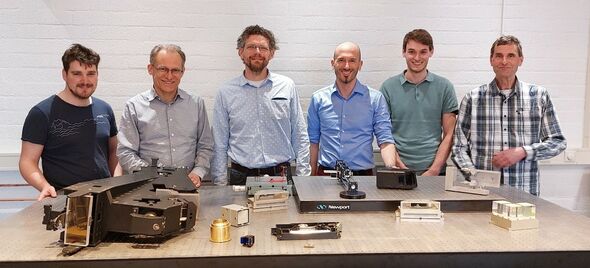Mechanical Engineering opts for optomechatronics
High-tech devices increasingly contain advanced optical sensors in order to deliver the required level of extreme accuracy. All the more reason for assistant professor Lennino Cacace and ‘hybrid teacher’ Pieter Kappelhof to put the mechanical engineering discipline ‘optomechatronics’ more emphatically on the map at TU/e. They have only been working on this for a few months, but have already managed to secure six PhD positions financed by the business sector: four in collaboration with ASML and two with Prodrive.
Within the field of optomechatronics, knowledge of optical systems – lasers, lenses, mirrors, light sensors – is combined with mechatronics, a discipline revolving around high-tech mechanical systems and their electronic control systems. In order to achieve continuous improvement in the construction of mechatronic systems, optical precision measurements – which are accurate down to the nanometer – have become an essential component of the discipline.
In the Brainport region, optomechatronics are indispensable for the development of ASML’s chip machines, FEI’s electron microscopes, Philips’ medical equipment and the wide range of high-tech components manufactured by Prodrive, among other things. It was therefore high time that this discipline was given an official place at TU/e, according to Lennino Cacace, who works part-time as an assistant professor in the Mechanical Design group (part of the Control Systems Technology group, CST) and Pieter Kappelhof, who is a hybrid teacher and uses his extensive experience in the high-tech industry to teach students one day a week.
Arizona
So while technology at the interface of mechanics, electronics and optics already plays a key role in the high-tech industry, Cacace argues that optomechatronics is still an understudied field in academia. “The only good research group working in this field is in Arizona. Here in Eindhoven, we have an excellent position to establish this discipline successfully, thanks to our tradition in the field of mechanical design and Brainport’s ecosystem.”
Both Kappelhof and Cacace are graduates of Mechanical Design and together, they have set up a master track in optomechatronics at TU Delft over the last few years. TU/e is now expanding its mechanical engineering education with a master’s course in optomechatronics, which will be an elective course for Mechanical Engineering students as of the next academic year. In addition, arrangements are currently being made for the same students to be able to take an optics course from the Applied Physics bachelor as a master’s course as well.
PhD positions
The Mechanical Design Lab also provides space for graduates and PhD students in the field of optomechatronics. They will be supervised by Cacace, while professors Maarten Steinbuch (head of the CST group) and his colleague Hans Vermeulen will act as PhD supervisors. “We think it’s important that students are aware that they can come to us if they’re interested in this direction.”
The fact that the regional business community is in need of personnel with knowledge in this field is beyond doubt, Kappelhof emphasizes: “At ASML alone, there is an optomechanical department that employs hundreds of people. Before we started, we visited the department together with Maarten Steinbuch and this immediately yielded four PhD positions, financed by ASML. Prodrive also made a substantial contribution, allowing us to initiate two PhD tracks. We have already filled the latter two positions and we’ve also already hired one PhD student who will be working with ASML.”
![[Translate to English:]](/fileadmin/_processed_/2/3/csm_BvOF_2016_0902_CC_-_reticle_van_ASML_d1cbe5d8ee.jpg)


Discussion